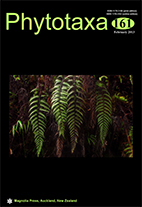Abstract
The genus Aspidistra (Asparagaceae) shows strong variation of flower groundplan. We add further evidence of this variation describing a new species, Aspidistra paucitepala from southern Vietnam that has flowers with 2-4 tepals, 2-4 stamens and a gynoecium with unilocular ovary. Bisexual flowers with three tepals and three stamens are extremely rare among monocots with biotic pollination. Compared with typical trimerous pentacyclic monocot flowers, they can be either interpreted as trimerous and tricyclic or as 1.5-merous (at least in perianth and androecium) and pentacyclic. Both interpretations imply floral features unusual for ‘higher’ Asparagales. Aspidistra paucitepala resembles recently described A. brachystyla from northern Vietnam in narrow funnel-shaped to nearly tubular perianth with very small lobes and short cylindrical pistil with stigma located below the level of anthers. As species of the taxonomically diverse genus Aspidistra are frequently observed in the field without reproductive structures and cannot be properly identified, a need for DNA barcoding approach is obvious. We present preliminary data showing that plastid psbA-trnH and nuclear 5S-NTS regions could be useful for DNA barcoding of Aspidistra.

